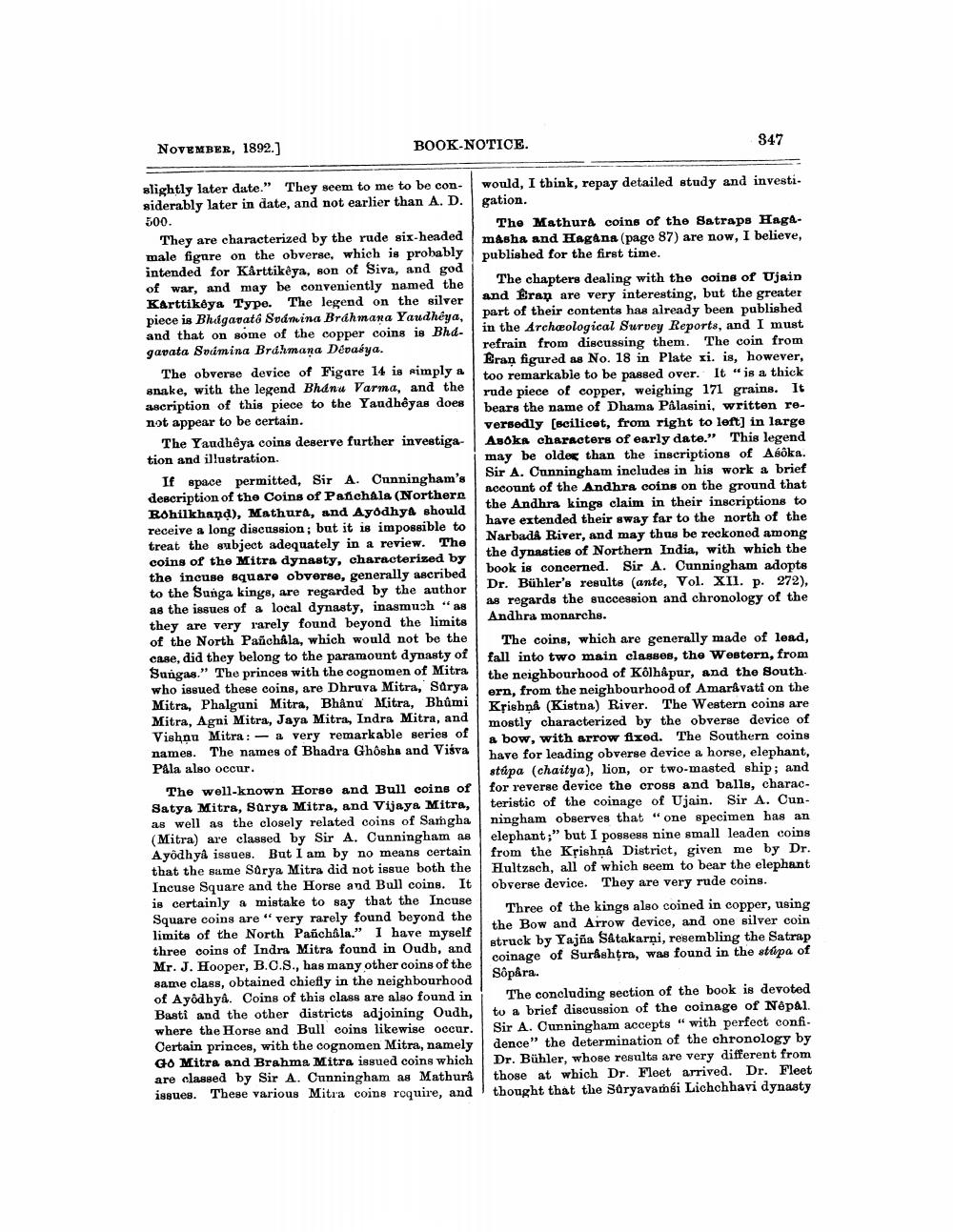________________
NOVEMBER, 1892.]
BOOK-NOTICE.
847
slightly later date." They seem to me to be con- would, I think, repay detailed study and investi. siderably later in date, and not earlier than A. D. gation. 500.
The Mathura coins of the Satraps HagaThey are characterized by the rude six-headed
masha and Hagana (page 87) are now, I believe, male figure on the obverse, which is probably
published for the first time. intended for Kårttikêya, son of Siva, and god of war, and may be conveniently named the
The chapters dealing with the coins of Ujain Karttikoya Type. The legend on the silver and Eran are very interesting, but the greater piece is Bhagavató Sudmina Brahmana Yaudhéya, part of their contents has already been published and that on some of the copper coins is Bhd. in the Archaeological Survey Reports, and I must gavata Sumina Brahmana Devasya.
refrain from discussing them. The coin from
Eran figured as No. 18 in Plate ri. is, however, The obverse device of Figare 14 is simply a
"pay too remarkable to be passed over. It “is a thick anake, with the legend Bhanu Varma, and the rude piece of copper, weighing 171 grains. It ascription of this piece to the Yaudhêyas does
bears the name of Dhama Palasini, written renot appear to be certain.
versodly (scilicet, from right to left) in large The Yaudhôya coins deserve further investiga- Asoka characters of early date.” This legend tion and illustration.
may be older than the inscriptions of Asoka. If space permitted, Sir A. Cunningham's
Sir A. Cunningham includes in his work a brief description of the Coins of Panchala (Northern
account of the Andhra coins on the ground that Rohilkhand), Mathura, and Ayodhya should
the Andhra kings claim in their inscriptions to
have extended their sway far to the north of the receive a long discussion; but it is impossible to treat the subject adequately in a review. The
Narbada River, and may thus be reckonod among coins of the Mitra dynasty, characterized by
the dynasties of Northern India, with which the the incuse square obverse, generally ascribed
book is concerned. Sir A. Cunningham adopts to the Sunga kings, are regarded by the author
Dr. Bühler's results (ante, Vol. XIl. p. 272), as the issues of a local dynasty, inasmush "as
as regards the succession and chronology of the they are very rarely found beyond the limits
Andhra monarchs. of the North Pañchåla, which would not be the The coins, which are generally made of load, case, did they belong to the paramount dynasty of
fall into two main classes, the Western, from Sungas." The princes with the cognomen of Mitra
the neighbourhood of Kolhapur, and the South who issued these coins, are Dhruva Mitra, Sarya
ern, from the neighbourhood of Amaravati on the Mitra, Phalguni Mitra, Bhånu Mitra, Bhumi
Krishna (Kistna) River. The Western coins are Mitra, Agni Mitra, Jaya Mitra, Indra Mitra, and
mostly characterized by the obverse device of Vishnu Mitra: - a very remarkable series of
a bow, with arrow fixed. The Southern coins names. The names of Bhadra Ghosha and Visva
have for leading obverse device a horse, elephant, PAla also occur.
stápa (chaitya), lion, or two-masted ship; and The well-known Horse and Bull coins of for reverse device the cross and balls, characSatya Mitra, Surya Mitra, and Vijaya Mitra, teristic of the coinage of Ujain. Sir A. Cun. as well as the closely related coins of Sangha ningham observes that "one specimen bas an (Mitra) are classed by Sir A. Cunningham as elephant;" but I possess nine small leaden coins Ayodhyd issues. But I am by no means certain from the Krishna District, given me by Dr. that the same Sorya Mitra did not issue both the Fultzach, all of which seem to bear the elephant Incuse Square and the Horse and Bull coins. It obverse device. They are very rude coins. is certainly a mistake to say that the Incuse
Three of the kings also coined in copper, using Square coins are "very rarely found beyond the limits of the North Pañchala." I have myself
the Bow and Arrow device, and one silver coin three coins of Indra Mitra found in Oudh, and
struck by Yajña Satakarni, resembling the Satrap Mr. J. Hooper, B.O.S., has many other coins of the
coinage of Surashtra, was found in the stúpa of same class, obtained chiefly in the neighbourhood
Sôpåra. of Ayodhya. Coins of this class are also found in The concluding section of the book is devoted Basti and the other districts adjoining Oudh, to a brief discussion of the coinage of Nepal where the Horse and Bull coins likewise occur. Sir A. Cunningham accepts "with perfect confi. Certain princes, with the cognomen Mitra, namelydence" the determination of the chronology by Go Mitra and Brahma Mitra issued coins which Dr. Bühler, whose results are very different from are classed by Sir A. Cunningham as Mathurs those at which Dr. Fleet arrived. Dr. Fleet issues. These various Mitra coins require, and thought that the Saryavamsi Lichchhavi dynasty




